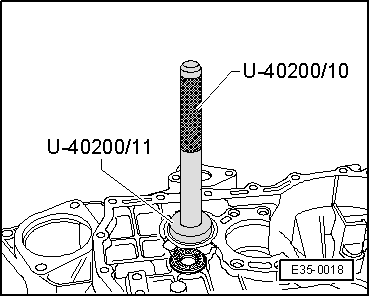Leon Mk1
| Adjusting input shaft |
| Consult the equivalence table for tools and equipment according to applicability among Seat / VW / Audi / Skoda → Chapter. |

| Special tools and workshop equipment required |
| t | Torque wrench kit -SAT 8010-, see equivalent → Anchor |
| t | Socket -T20020-, see equivalent → Anchor |
| t | Kit (case) -U 40200A-, see equivalent → Anchor |
| t | Kit (case) -U 40300-, see equivalent → Anchor |
|
|

|
|

|
 Note
Note
 Note
Note
|

|
| Bearing play, measured value | Thickness of shim according to table |
| 1.21 mm | 1.175 mm |
|
| Bearing play | Shim |
| Measured value (mm) | Thickness (mm) |
| 0,671…0,699 0,700…0,724 0,725…0,749 | 0,650 0,675 0,700 |
| 0,750…0,774 0,775…0,799 0,800…0,824 | 0,725 0,750 0,775 |
| 0,825…0,849 0,850…0,874 0,875…0,899 | 0,800 0,825 0,850 |
| 0,900…0,924 0,925…0,949 0,950…0,974 | 0,875 0,900 0,925 |
| 0,975…0,999 1,000…1,024 1,025…1,049 | 0,950 0,975 1,000 |
| 1,050…1,074 1,075…1,099 1,100…1,124 | 1,025 1,050 1,075 |
| 1,125…1,149 1,150…1,174 1175…1,199 | 1,100 1,125 1,150 |
| 1,200…1,224 1,225…1,249 1,250…1,274, | 1,175 1,200 1,225 |
| 1,275…1,229 1,300…1,324 1,325…1,349 | 1,250 1,275 1,300 |
| 1,350…1,374 1,375…1,399 1,400…1,424 | 1,325 1,350 1,375 |
| 1,425…1,449 1,450…1,474 1,475…1,499 | 1,400 1,425 1,450 |
| 1,500…1,524 1,525…1,549 1,550…1,574 | 1,475 1,500 1,525 |
| 1,575…1,599 1,600…1,624 1,625…1,649 | 1,550 1,575 1,600 |
| 1,650…1,674 1,675…1,699 1,700…1,724 | 1,625 1,650 1,675 |
 Note
Note
|
|

|
